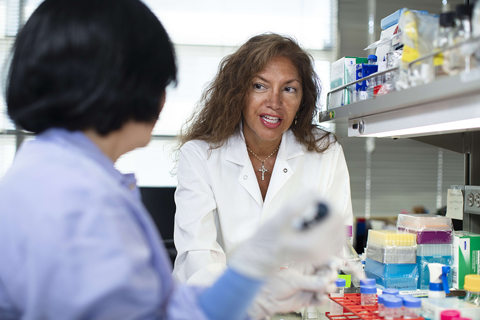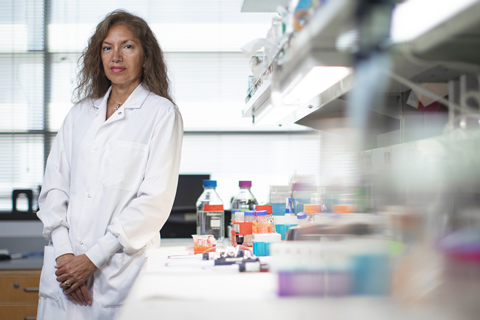Bio-Science: Lali Medina-Kauwe, PhD
With this story, we launch "Bio-Science," an occasional series profiling the people who help drive Cedars-Sinai’s growing research enterprise.
"I like wild ideas, and I've been given an opportunity to test them," said Lali Medina-Kauwe, PhD, an investigator at Cedars-Sinai Cancer and co-founder of the biotech company Eos Biosciences Inc. in Los Angeles.

Lali Medina-Kauwe, PhD, (right) at work with her lab manager, Michelle Wong.
Medina-Kauwe is using her creativity to pioneer the fledgling field of nanomedicine—the engineering of tiny particles for medical uses. Among her many inventions is HerDox, a particle she calls a "chemotherapy smart bomb." HerDox encapsulates a chemotherapy agent inside a bioengineered protein to help the chemical find and penetrate cancer cells while sparing normal cells from damage.
The Los Angeles native, a professor of Biomedical Sciences, said she has been creative since she was a child.
"I come from a family of talented artists. My mom was an expert seamstress, and my dad was a musician with a beautiful voice," she explained. "As a child, I would take a matchbook and turn it into a dresser for my dolls. I deconstructed and repurposed it, much as I do with proteins in my work today."
Medina-Kauwe's interest in nanomedicine dates to the late 1990s, when she was pursuing postdoctoral training at Keck School of Medicine of USC after earning a PhD in molecular biology from UCLA.
"I was very interested in gene therapy," she said. "I found out that the main driver in that field was producing targeted viral vectors—viruses that ferry experimental genes into cells to attack diseases. I realized there was good reason to look into non-viral ways to deliver genes to dispense with concerns associated with viruses. I thought, 'I think I can make a non-viral vector from just the protein.'"
And so she did. Medina-Kauwe created the HerDox nanoparticle by deconstructing a viral vector, using the minimal compound necessary. At first, she tested this compound, which she called HerPBK10, as a gene-delivery vehicle. Then she hit on the idea of using it to package doxorubicin, a cancer chemotherapy agent, to help the doxorubicin home in on tumor cells.
"When we started doing the preliminary studies in the lab with this new nanoparticle, it was fantastic," she recalled. "It targeted the tumor, allowing us to reduce the therapeutic dosage needed to get tumor shrinkage with fewer side effects." HerDox is directed at HER2-positive breast cancer tumors, a type that is especially hard to treat.

Medina-Kauwe is shown in her lab.
Medina-Kauwe has since developed several other nanoparticles that rely on the HerPBK10 protein. These include HerMn, designed to both kill cancer cells and enhance magnetic resonance imaging of tumors; H2PO, which delivers therapeutic genes into cancer cells; and HerSi, which manipulates genes and the immune system. Her research has been supported by the National Institutes of Health, Department of Defense, American Cancer Society and many other groups.
The patents for Medina-Kauwe's inventions are held by Cedars-Sinai and licensed to Eos Biosciences Inc., where she is acting chief scientific officer. She hopes that one day these inventions, so far tested only in the laboratory, may lead to cancer treatments.
Leon Fine, MD, who chaired the Department of Biomedical Sciences from 2007 to 2017, calls Medina-Kauwe "a really important personality in the basic science area at Cedars-Sinai. She is an independent, federally funded researcher and an effective collaborator."
Medina-Kauwe is currently studying the blood-brain barrier, which prevents toxins from entering brain tissue but also can keep out therapeutic drugs, thwarting treatment of brain tumors. She has teamed up with Cedars-Sinai colleagues to test the ability of nanoparticles to shuttle therapeutics across this barrier.
As with her innovative bent, Medina-Kauwe's focus on fighting cancer, especially drug-resistant types, has family ties.
"My mother went through chemotherapy for ovarian cancer," she said. "She responded well to treatment, and then the cancer came back. The follow-up chemo made her so sick. She opted to stop treatment and went into hospice. My grandmother also went through chemo for gynecologic cancer.
Today, she added: "A lot of people I know are getting cancer. Many of them go through treatment and then regress. When I hear that, it is so personal. I think, 'Not again!'"
Besides conducting her own inventive research, Medina-Kauwe helps students and postdocs pursue their career passions. She is one of two co-directors, along with Michelle Jones, PhD, of the Graduate School of Biomedical Sciences, directed by William Parks, PhD. She has twice won the David L. Rimoin Teaching Excellence Award bestowed annually by student vote.
"Students find it very easy to approach Lali, and they respect her advice," said David Underhill, PhD, who directed the graduate school from its inception through 2016.
The benefits of mentoring go both ways. Medina-Kauwe said her blood-brain barrier research was spurred by postdocs in her lab who found that certain of her nanoparticles were appearing in brain tissue. "I was skeptical," she admitted. "I didn't think they would be there." Further tests confirmed the particles indeed had sneaked past the blood-brain barrier.
And with that, Medina-Kauwe was headed down her latest pioneering pathway.
